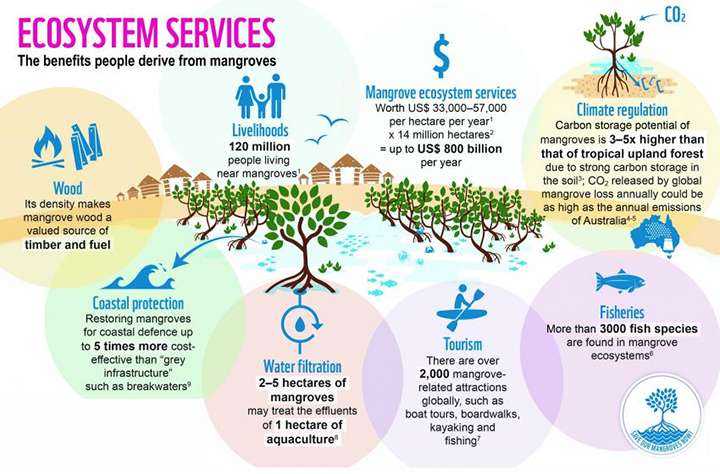Biodiversity & Environment
Genome of Salt-secreting Mangrove Species Decoded
- 23 Jul 2021
- 6 min read
Why in News
Recently, the scientists for the first time have decoded the reference-grade whole genome sequence of a highly salt-tolerant and salt-secreting mangrove species, Avicennia marina.
- This study was led by the Department of Biotechnology (DBT)-Institute of Life Sciences, Bhubaneswar.
Key Points
- Avicennia Marina:
- It is one of the most prominent mangroves species found in all mangrove formations in India.
- It is a salt-secreting and extraordinarily salt-tolerant mangrove species that grows optimally in 75% seawater and tolerates >250% seawater.
- It is among the rare plant species, which can excrete 40% of the salt through the salt glands in the leaves, besides its extraordinary capacity to exclude salt entry to the roots.
- It is also referred to as grey mangrove or white mangrove.
- Significance of Study:
- This study assumes significance as agriculture productivity globally is affected due to abiotic stress factors such as limited water availability and salinization of soil and water.
- Availability of water is a significant challenge to crop production in dryland areas, accounting for 40% of the world’s total land area.
- Salinity is prevalent in 900 million hectares globally (with an estimated 6.73 million ha in India), and it is estimated to cause an annual loss of 27 billion USD.
- The genomic resources generated in the study will pave the way for researchers to study the potential of the identified genes for developing drought and salinity tolerant varieties of important crop species of the coastal region that is significant for India with 7,500m of coastline and two major island systems.
- This study assumes significance as agriculture productivity globally is affected due to abiotic stress factors such as limited water availability and salinization of soil and water.
Mangrove
- About:
- A mangrove is a small tree or shrub that grows along coastlines, taking root in salty sediments, often underwater.
- The word ‘mangrove’ may refer to the habitat as a whole or to the trees and shrubs in the mangrove swamp.
- Mangroves are flowering trees, belonging to the families Rhizophoraceae, Acanthaceae, Lythraceae, Combretaceae, and Arecaceae.
- Features of Mangroves:
- Saline environment: They can survive under extreme hostile environments such as high salt and low oxygen conditions.
- Low oxygen: Underground tissue of any plant needs oxygen for respiration. But in a mangrove environment, the oxygen in soil is limited or nil. Hence the mangrove root system absorbs oxygen from the atmosphere.
- Mangroves have special roots for this purpose called breathing roots or pneumatophores.
- These roots have numerous pores through which oxygen enters the underground tissues.
- Succulent leaves: Mangroves, like desert plants, store fresh water in thick succulent leaves.
- A waxy coating on the leaves seals in water and minimises evaporation.
- Viviparous: Their seeds germinate while still attached to the parent tree. Once germinated, the seedling grows into a propagule.
- The mature propagule then drops into the water and gets transported to a different spot, eventually taking root in a solid ground.
- Threat:
- Constructions: At least one third of all mangrove forests has been lost during the last few decades. Coastal development, including construction of shrimp farms, hotels, and other structures, is the primary threat to mangroves.
- Mangrove forests are cleared to make room for agricultural land and human settlements.
- Overharvesting: Mangrove trees are used for firewood, construction wood, charcoal production, and animal fodder.
- In some parts of the world, there has been overharvesting which is no longer sustainable.
- Others: Overfishing, pollution, and rising sea levels are the other threats to mangrove forests and their ecosystem.
- Constructions: At least one third of all mangrove forests has been lost during the last few decades. Coastal development, including construction of shrimp farms, hotels, and other structures, is the primary threat to mangroves.
- Area Covered:
- Global: Mangroves can be found in over 118 countries and territories in the tropical and subtropical regions of the world.
- Asia has the largest coverage of the world’s mangroves, followed by Africa, North and Central America, Oceania and South America.
- Approximately 75% of the world’s mangrove forests are found in just 15 countries.
- India:
- According to the State of Forest Report 2019, mangrove cover in the country is 4,975 sq km, which is 0.15% of the country’s total geographical area.
- Mangrove cover in the country has increased by 54 sq km (1.10%) as compared to the previous assessment (2017).
- The deltas of the Ganges, Mahanadi, Krishna, Godavari, and the Cauvery rivers contain mangrove forests.
- The backwaters in Kerala have a high density of mangrove forest.
- The Sundarbans in West Bengal is the largest mangrove region in the world and a UNESCO World Heritage Site.
- It spans from the Hooghly River in West Bengal to the Baleswar River in Bangladesh.
- The Bhitarkanika mangrove system in Odisha is India’s second largest mangrove forest.
- Pichavaram in Tamil Nadu has a vast expanse of water covered with mangrove forests. It is home to many aquatic bird species.
- West Bengal has 42.45% of India’s mangrove cover, followed by Gujarat 23.66% and A&N Islands 12.39%.
- According to the State of Forest Report 2019, mangrove cover in the country is 4,975 sq km, which is 0.15% of the country’s total geographical area.
- Global: Mangroves can be found in over 118 countries and territories in the tropical and subtropical regions of the world.





